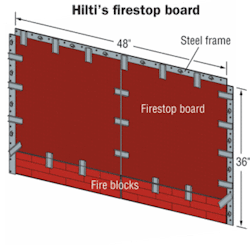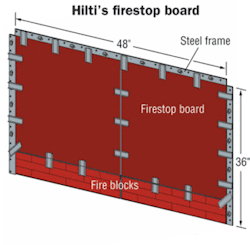The International Firestopping Council is on a mission to educate both contractors and building inspectors about the importance of proper firestopping.
The IFC (Chelmsford, MA, www. firestop.org) is a non-profit organization of industry experts committed to making buildings safer through passive fire containment. Passive fire protection functions to contain fires within the areas in which they start, preventing loss of life by preventing the products of combustion (smoke, hot gases and flames) from spreading throughout a building.
Firestopping involves using bricks, pillows and other devices made of intumescent material to contain fires around cables. Firestop systems protect against the passage of flames, deadly gases and toxic smoke through openings that are created for penetrations, joints and gaps in fire-resistive walls, floors and ceiling assemblies.
The CP 675T Firestop Board, one example of firestopping products manufactured by Hilti Corp., is designed for the temporary or permanent sealing of blank openings or through penetrations in fire-rated walls. The board can be surface-mounted for an economical solution in low re-penetration applications. It uses fire blocks-bricks of intumescent material, which are mounted on its bottom section. Contractors can remove the blocks, insert cable through the opening, and then replace the blocks. Cable can be added to this arrangement, even filling up the entire board if necessary.
IFC Vice President Jim Park says firestopping must be installed in the manner in which it was tested. Today, the council sees a lack of proper firestopping education in the market, and Park says the mistakes can be seen in poor firestopping on the part of contractors, and bad decision-making by building inspectors who give the final approval to the work.
“It is by far the largest obstacle we have,” says Park. “You have honest contractors who are full of integrity who do it wrong.”
Park’s team is aggressively trying to get the message out to contractors. It is spending more on public relations initiatives, and planning building inspector educational sessions at conferences throughout the world. One fall seminar was launched in October in Winnipeg, Manitoba. The council is also conducting substantial testing on products from major manufacturers in its in-house test facility.
The IFC also has an education committee that has hired a new executive director, Hubert Dudley, who will be responsible for the organization’s business and financial management, coordinating member and external communications, and steering education, training and marketing initiatives. Dudley will also serve as a representative of the association at industry trade shows, conferences and speaking engagements.
All of these efforts are meant to address what Park describes as an ongoing problem-that contractors are often lax when it comes to properly installing firestopping devices, and building inspectors are ill-informed about what to look for during an inspection.
“The problem is, building codes are ever-changing,” says Park.
Problems from the installation and inspection side, he notes, can involve anything from the “fly-by-night” installer to the poorly informed building inspector. “The building inspector can be highly educated or an unemployed vagrant whose wife knows the mayor,” says Park.
“It’s all about education,” Park continues. “They shouldn’t reject or accept this. They should accept it.”
Park says the problem is at its worst in smaller cities, where education about firestopping is lacking. But he is quick to note that many small cities suffer from a dearth of building inspectors. The IFC vice president says a small city could have up to 12,000 building permits issued annually, and with only 12 building inspectors to inspect all of the work. “Sometimes they are so busy, education just isn’t as important,” says Park.
On the other side of the spectrum, Park says building inspectors will inspect properly installed firestopping, which incorporates material that was UL-tested and approved, and then reject the job simply because “they have a bad feeling.”
Park claims the worst firestopping inspection problems can be found in southern states, but even in states where there is good enforcement, he says contractors still make mistakes and building inspectors fail to pick up on it.
And part of the problem is that the architecture for firestopping is largely out of sight, out of mind.
“If you leave the roof off, it’s obvious,” says Park. “But if you leave out fire protection, nobody will ever notice it until there is a fire.”

